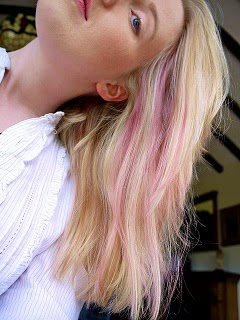
|
| [1] |
What is developer?
Developer is a solution of hydrogen peroxide, water, and other ingredients like conditioning agents. It is the hydrogen peroxide in this solution that creates an oxidative environment when combined with permanent hair dye, allowing the dye to work.
This oxidation is necessary for the color to develop, and causes it to gradually change into the intended shade after the dye enters the hair shaft. It's a chemical change that forms bonds in the dye molecules, allowing it to become permanent. Without developer, permanent hair coloring wouldn't be possible.
Developer also lightens your natural pigment, causing your hair to become lighter. How much lightening occurs is determined by the developer volume. This is a way to describe the strength of the hair color developer based on how much oxygen it produces, and this can be converted into a percentage of peroxide. Either measurement can be used to choose the right developer.
Volumes of hair color developer
Developer can be divided into specific strengths that are commonly used in hairdressing. These strengths are:
- 10 vol developer (3%)
- 20 vol developer (6%)
- 30 vol developer (9%)
- 40 vol developer (12%)

|
| [2] |
20 vol developer
This volume of developer can be used for a variety of different purposes. Most importantly, it provides 1 - 2 levels of lightening where necessary. This means you can use it in conjunction with your dye to lighten and dye your hair up to 2 levels lighter.
It can also be used to dye resistant hair to a darker color. Resistant hair doesn't take color very well and fades easily. A higher volume of developer like this helps to penetrate the hair shaft and properly develop the dye for better results.
The same sort of scenario takes place in grey hair, which often needs a stronger developer to produce longer lasting results, as well as lighten darker strands of hair if the grey is a salt-and-pepper shade to produce a more even result after coloring.

|
| [3] |
30 vol developer
This strength of developer is used to provide up to 3 levels of lightening with permanent dye. It shouldn't be used if you are toning or darkening your hair, as it is more damaging than a weaker developer.
When using blonde dyes to lighten and dye your hair blonde, this is the developer that is generally used. In combination with the greater ammonia content of blonde dyes, this gives even better lightening. However, more ammonia can also increase damage, even though it benefits color penetration and lift.
40 vol developer
This developer volume is the strongest that should be used, and even then it has limited uses. You can mix it into any brand of permanent dye that allows its use, but some brands do not recommend using it. This is because many dye brands won't benefit from such a high strength hair color developer due to their formulation. High lift dye, on the other hand, is designed to use it properly.
You also shouldn't mix it with hair bleach in most cases. The use of a hair color developer this strong in bleach is very damaging to your hair, and can even be dangerous for your scalp. The few brands that allow it to be used, generally only recommend using it for off-scalp highlights where the product won't touch your skin.

|
| [4] |
Other developer strengths
Whilst the four listed hair color developers are the most common and generally standard, others do exist depending on which brand you're using. Many salon brands like Wella produce their own formulations to work better with their own dyes and bleach, as well as encourage you to buy more of their products.
Other times you may encounter strengths below 10 vol which are used with demi-permanent dyes. These strengths are very mild and are used to oxidise the demi-permanent color and help it penetrate without leading to a completely permanent color result or causing as much damage.
More information:
- How to use salon dye - Professional dye always produces a better and longer lasting color than other alternatives. Find out how to use it...
- The color wheel - Discover a useful tool that can help you tone your hair or correct an unwanted color...
- Tips for coloring hair - Want salon results at home? Here are the best practices to ensure that you're applying your new color properly for the best results...
Have a question about hair color developer or how to properly use it for your own hair? Leave a comment for tailored advice...
No comments:
Post a Comment